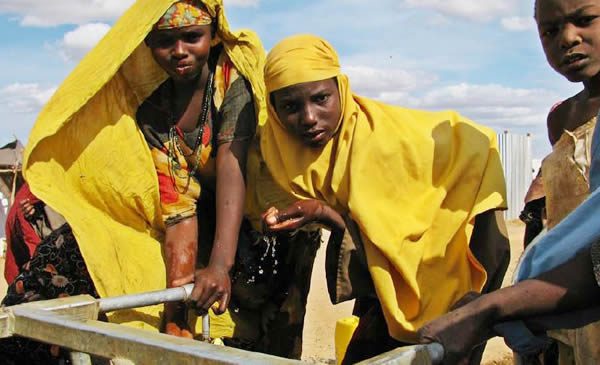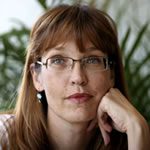
By Nicole Johnston, Regional Media and Communications Coordinator, Oxfam Great Britain

Secretly, I was rather dreading Dadaab. For weeks I’d seen the images on TV: babies so emaciated they looked like a bundle of twigs wrapped in cloth; elderly people dying, their faces shrouded in a cloud of flies. I was bracing myself, mentally preparing to try to bear the unbearable and do the best job I could.
I hadn’t reckoned on being buoyed by the incredible energy that is generated by the half a million people living in the world’s biggest refugee camp, by engaging with people as three-dimensional human beings instead of cardboard cut-out caricatures of suffering, and most of all by their hope.
This is not in any way to diminish the real tragedy that is unfolding in the Horn of Africa – and will continue to unfold if the famine worsens in Somalia, as the UN predicts. But while those terrible pictures of death and suffering – the “famine pornography” as it has come to be known – are undeniably part of the picture, they are not the whole picture.
What those images do not show is the incredible resilience of the refugees, their ability to envision a better life for themselves and their fierce dignity in the face of experiences that would leave most of us crushed.
What humbled me most were the many stories I heard about villagers who themselves had almost nothing, sharing food and water with the refugees as they fled Somalia, simply because their humanity would not allow them to turn starving people away.
I met a man who had walked for five days – in the “wrong” direction, against the streams of people leaving – to rescue his late brother’s child before turning around and collecting his own family for the 30 day trek to Dadaab.
In Ifo camp we met a refugee who had been been diagnosed with breast cancer, had a tumour removed in Somalia and subsequently lost her breast. She reminded me that being a refugee does not exempt you from the other horrors of life. Along with her four children and elderly mother she had been taken in by a member of the long standing refugee community in Ifo, who has managed to build a brick house. “I couldn’t let this woman go stay in a tent – it is my responsibility to help her and make sure she is taken care of,” her host told me, surprised that I would even ask why she was helping.
Doctors in the camp say her cancer is too far gone and there is nothing more they can do for her, but that hasn’t stopped volunteers from Global Somali Emergency Response – a group of Somali students from the across the diaspora – raising money to try and help her access more specialized treatment. We visited her several times, and each time we joined the road to her house, total strangers would flag us down and say
“Are you going to visit the sick lady? Please try to help her.”
During Ramadan I was touched to see members of the long term refugee community distributing dates, milk and maize meal to newly arrived refugees. Abdulahi Mohamed Sahal has lived in Dadaab for 20 of his 23 years, his family having arrived during the last major famine in the early 1990s. “This food is a welcoming gift from our community, bought with donations from mosques. We see people who are hungry, so we should help,” he explains simply.
Within days of arrival, those refugees who have the means will set up small shops while others will sell their skills as tailors or teachers. Many will sign up for “cash for work” programmes run by NGOs like Oxfam, where refugees and members of the local host community can earn money by digging trenches, laying water pipes and casting latrine slabs. Parents club together to pay a teacher to run a madressa, where children sit in the open air under the harsh sun. They have no books, or blackboards or pencils so they practice writing on wooden boards using homemade ink. No one I met was sitting around with their hands out: everyone was making a plan to improve their lives.
The reality is that people in Dadaab are as complex and human as anyone else, anywhere else: on more than one occasion we were told to bugger off by people who have had enough of foreigners with notebooks and cameras. Those who portray the refugees as either uniformly tragic, or as unvaryingly grateful happy people do not do justice to their humanity.
What the TV cameras cannot capture is the energy and commitment of the scores of aid workers in the camp. The majority of the people who work installing water tanks, processing refugee documentation and distributing food are Kenyans – a far cry from the stereotype of the “White and Western” aid worker who parachutes into a context they know nothing about. Many of them are Muslim and I was awed by their capacity to work a full day in the field, in extreme heat and dust, while fasting. The feminist in me enjoyed the fact that our team is managed by a group of no-nonsense East African women, all experts in their technical areas – and nothing like the stereotype of the disempowered African woman.
It was gratifying to see their hard work bearing fruit and to witness how donations from across the world were transformed into tangible humanitarian aid: clean water running and latrines built, sleeping mats, soap and pots and pans for new arrivals. It was good to witness progress in improving refugees’ living conditions, as families were moved from Dagahaley into newly erected tents in the Ifo II camp, where there are much needed facilities such as schools and clinics.
But most of all, as an African this crisis has also increased my conviction that we can make a difference. It has galvanised our sense of ubuntu, with ordinary citizens across this continent showing solidarity with fellow Africans. The fundraising efforts of groups like Kenyans for Kenya and Gift of the Givers have encouraged people to dig deep for the crisis, with citizen contributions often surpassing the amounts donated by national governments. While the amount pledged by most African governments in Addis Ababa recently was – as civil society coalition Africans Act 4 Africa put it – “paltry”, the bright spot of the day was an address by 11 year old Andrew Adansi from Ghana. He became a media darling when he was so moved by TV reports on the plight of Somali children that he raised money from his school friends. To date, he has raised $4000, and wasn’t taking any prisoners at the AU: he warned the leaders who hadn’t coughed up that he would visit them personally to collect their cheques.
There is a Somali proverb that says “If people come together, they can even mend a crack in the sky.” It won’t be easy, but my experience in East Africa has shown me that the will and the courage are there.
This article was originally published in the 7 September 2011 edition of iMaverick
Read more about Oxfam’s response to crisis
Make a donation to the Africa Food Crisis Appeal